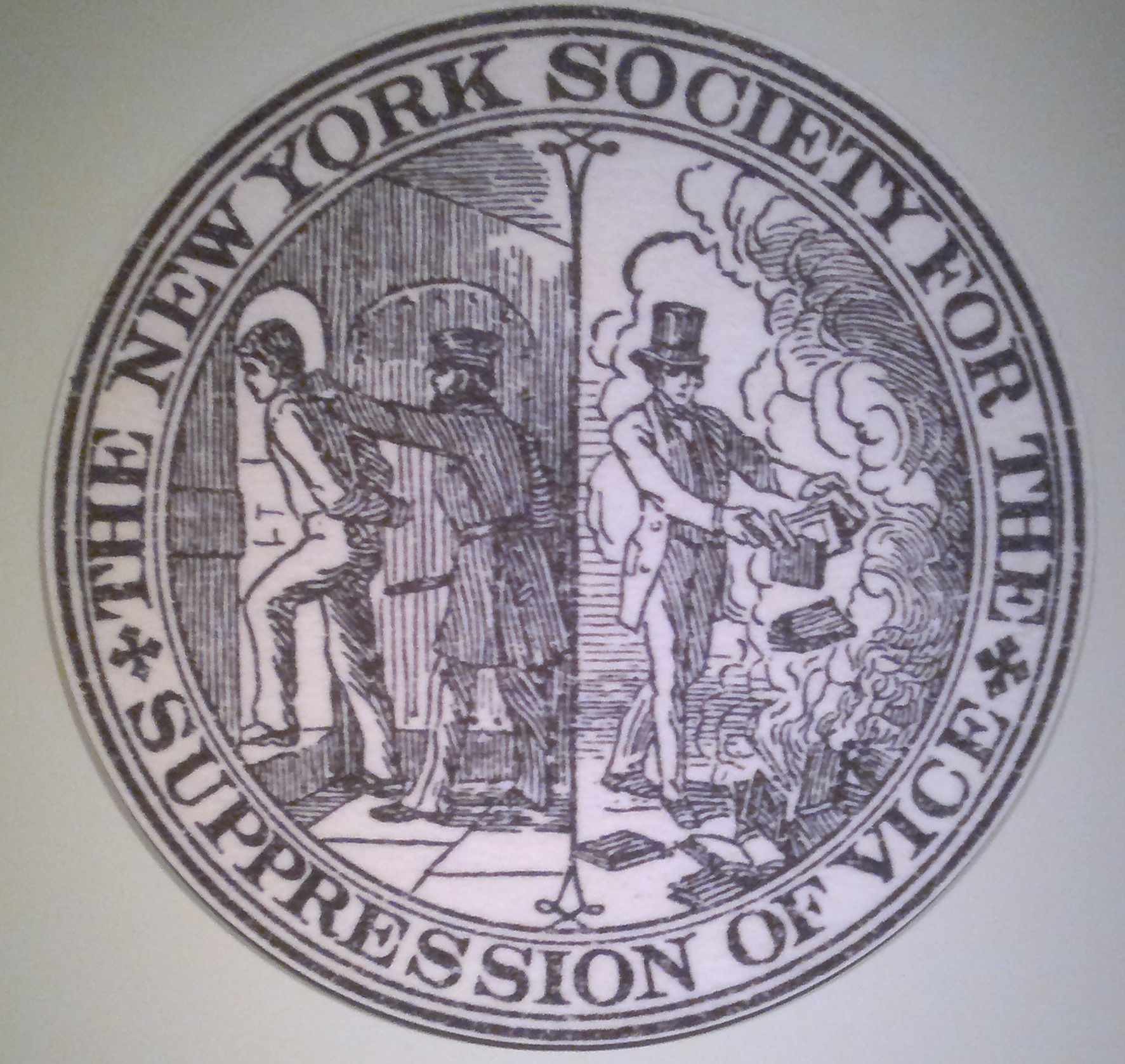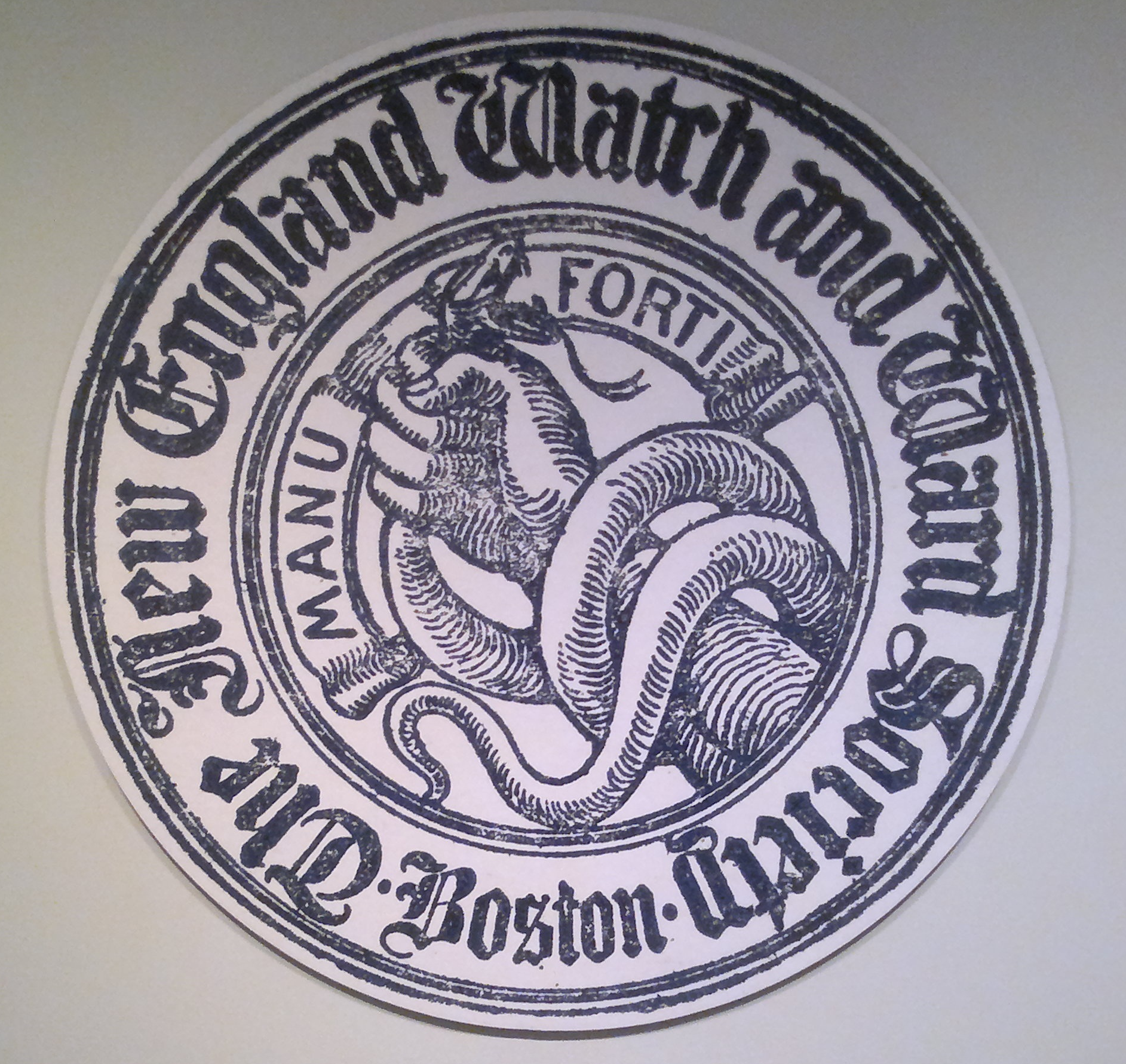
Photo by Jake Ptacek
We here at viz are deeply excited about our new partnership with the Harry Ransom Center, one of the premier research libraries for the humanities in the United States. As part of that partnership, we’ve been given a tour of their current exhibitions and the chance to blog about some of the Center’s amazing holdings. You may have already had a chance to read Matthew Reilly’s meditation on their Banned, Burned, Seized, and Censored exhibit and Jay Voss’s post on The Greenwich Village Bookshop Door exhibition. Continuing that thread, this week I want to look more closely at two artifacts on display in the BBSC exhibit: the official seals for the New York Society for the Suppression of Vice and the New England Watch and Ward Society.

Photo by Jake Ptacek
I won’t rehash the history of either institution too much—something the Center exhibit does more thoroughly and forcefully than I can do here—but I am fascinated by the differing visual appeals of each seal. The New York Society for the Suppression of Vice (or NYSSV--sorry there’s no less ungainly acronym) seal creates a tiny narrative. In the left portion of the seal, an official-looking jailer pushes a young man through what must be one of the thickest doors in New York, into the darkness beyond. On the other half, a well-dressed gentleman tosses books onto a blazing fire—and it’s hard not to see a self-satisfied smirk on his face. The seal is a brilliant bit of propaganda. By representing the two acts in the same space, it posits a connection. They become two sides of the same coin. Never mind, of course, that the images are discontinuous—there’s no explanation as to what the criminal has to do with the books being tossed into the fire. Once you’ve seen the image, it’s virtually impossible to unsee the connection, to separate out the different narratives on a gut level.
I should add here that the narrative inscribed on the NYSSV’s seal is far from theoretical. Though technically a private endeavor—it originated through founder Anthony Comstock’s contacts in the YMCA—the NYSSV was chartered by the New York state legislature. Its members had the legal power to raid bookstores, seize material, and make arrests. Under Comstock’s successor, John S. Sumner, the NYSSV raided dozens of bookstores, impounded untold numbers of books, and prosecuted (or attempted to prosecute) dozens of novels and magazines, ranging from Ulysses to Real Forbidden Sweets. The seal was no idle threat, but a history: real people went to prison, and real books were burned, in the name of public morality.
There’s one final irony to the NYSSV’s seal. Perhaps it’s unintentional, or perhaps it’s the “lefty” politics in me looking for evidence of some Orwellian dystopia, but I wonder: when it’s read in the standard left-to-right way of to Western readers, the seal begins with an imprisonment before it gets to the “suppression of vice” (i.e the book burning). In other words, you go first, and the books after you. It’s a warning to everyone that what you read might not even be marked out yet as dangerous. A vicious book might be defined, not by its effect on you, but by your effect on it. There's a looking-glass mentality at work here which upsets the traditional narrative of a book's influence ("vicious books make bad citizens"). Instead, the seal seems to suggest that "bad citizens read bad books;" sadly, this would not be the last time that 20th century politics would rewrite cultural narratives.

Photo by Jake Ptacek
The New England Watch and Ward Society’s seal is—let’s face it—cooler. A hand throttles the snake coiled around it beneath the legend, “Manu Fortis”—“With a strong hand.” The symbolism is startling and direct, with all the subtlety of a Mack truck. While the NYSSV felt the need to narrativize and to demonstrate the effects of vice, the Watch and Ward Society—even the name is less linear—creates an iconography of power. The snake, with all its biblical associations intact, has fangs extended, ready to strike. Only a powerful (and, needless to say, masculine) hand can protect all the innocents who undoubtedly crouch just outside the frame of the seal. And it’s worth mentioning again, that hand isn’t just holding the snake, it’s crushing it. The seal makes a brilliantly simple, if disturbingly violent, claim to power.
A kind of sister organization to the NYSSV, the Watch and Ward Society was based out of Boston, where membership was largely composed of the “Brahmin aristocracy” (membership was only available to men). Unlike the NYSSV, the Watch and Ward society had no actual legal authority to impound books or make arrests; they relied on legal protest and challenges to ban books. Perhaps it’s no surprise, then, that their seal is more cannily metaphorical (and perhaps a slight case of over-compensation for their legal impotence). The Watch and Ward Society was no less effective, though: the phrase “banned in Boston” has entered the lexicon thanks to their efforts.

Image: Wikimedia Commons
As the poster above demonstrates, the visual rhetoric of book censorship had to change dramatically after the Nazi Party began putting into action on a state-implemented level what had previously been only the wildest fantasy of book censors (though I personally deplore the actions of the NYSSV and the Watch and Ward Society, the calibrations of their acts are, of course, far different than those of the Nazi Party). No longer could smiling book burners be depicted on state-supported seals, and the inherent claims of the Watch and Ward Society’s seal needed to be re-evaluated in a society that had witnessed the liquidation of personal freedoms and identity on a previously unimaginable scale. Ironically, this visual image itself comes from Boston, where the Boston Public Library emerged as quiet defenders of freedom of publication.
Both Societies struggled to survive in a post-WWII society. The NYSSV changed its name to the Society to Maintain Public Decency in 1947, and quietly dissolved after the retirement of Sumner, whose charisma had kept the Society afloat through a series of legal defeats. In 1948 the new head of the Watch and Ward Society, Dwight Spaulding, redirected its focus towards gambling and other social issues. Today, after several mergers and filiations, the Society’s endowments are part of the much different Community Resources for Justice group, which works to promote prison reform and ex-convicts’ rights.
Censorship, of course, hasn’t gone away, and new media fields—film, various iterations of popular music, video games—continue, along with books, to be targeted as corrupting influences on America’s youth. The act of censorship itself, though, has largely become a local issue, which tends to hide its prevalence, except in certain high-profile cases. It seems unlikely (though not, of course, impossible) that any American group will so dramatically visualize censorship as iconically and dramatically as these two. Is it possible to feel nostalgia for the obvious?
Recent comments
2 years 29 weeks ago
2 years 44 weeks ago
2 years 44 weeks ago
2 years 50 weeks ago
3 years 4 weeks ago
3 years 4 weeks ago
3 years 4 weeks ago
3 years 6 weeks ago
3 years 6 weeks ago
3 years 6 weeks ago